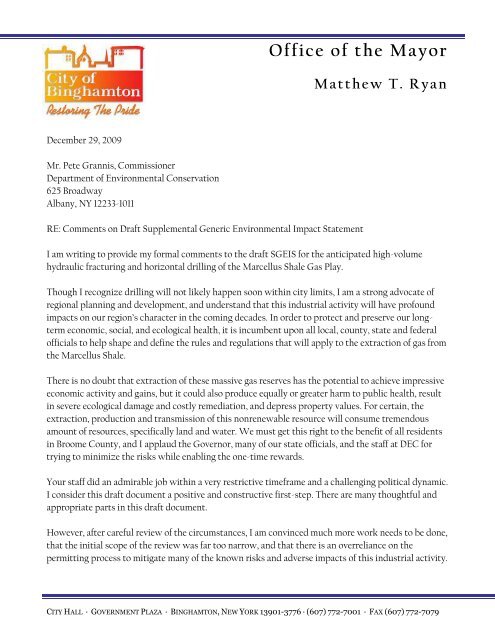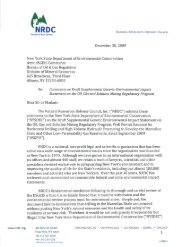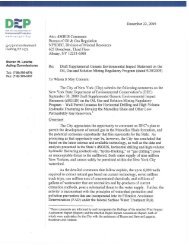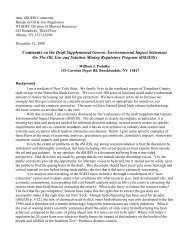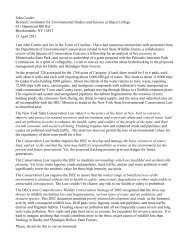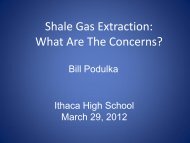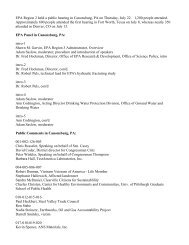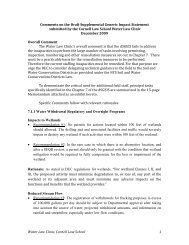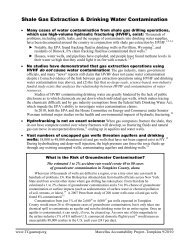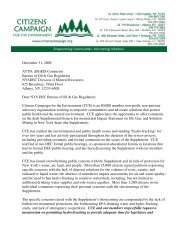Matthew T. Ryan, Mayor of Binghamton
Matthew T. Ryan, Mayor of Binghamton
Matthew T. Ryan, Mayor of Binghamton
Create successful ePaper yourself
Turn your PDF publications into a flip-book with our unique Google optimized e-Paper software.
December 29, 2009<br />
Mr. Pete Grannis, Commissioner<br />
Department <strong>of</strong> Environmental Conservation<br />
625 Broadway<br />
Albany, NY 12233-1011<br />
Office <strong>of</strong> the <strong>Mayor</strong><br />
RE: Comments on Draft Supplemental Generic Environmental Impact Statement<br />
M atthew T. <strong>Ryan</strong><br />
I am writing to provide my formal comments to the draft SGEIS for the anticipated high-volume<br />
hydraulic fracturing and horizontal drilling <strong>of</strong> the Marcellus Shale Gas Play.<br />
Though I recognize drilling will not likely happen soon within city limits, I am a strong advocate <strong>of</strong><br />
regional planning and development, and understand that this industrial activity will have pr<strong>of</strong>ound<br />
impacts on our region’s character in the coming decades. In order to protect and preserve our longterm<br />
economic, social, and ecological health, it is incumbent upon all local, county, state and federal<br />
<strong>of</strong>ficials to help shape and define the rules and regulations that will apply to the extraction <strong>of</strong> gas from<br />
the Marcellus Shale.<br />
There is no doubt that extraction <strong>of</strong> these massive gas reserves has the potential to achieve impressive<br />
economic activity and gains, but it could also produce equally or greater harm to public health, result<br />
in severe ecological damage and costly remediation, and depress property values. For certain, the<br />
extraction, production and transmission <strong>of</strong> this nonrenewable resource will consume tremendous<br />
amount <strong>of</strong> resources, specifically land and water. We must get this right to the benefit <strong>of</strong> all residents<br />
in Broome County, and I applaud the Governor, many <strong>of</strong> our state <strong>of</strong>ficials, and the staff at DEC for<br />
trying to minimize the risks while enabling the one-time rewards.<br />
Your staff did an admirable job within a very restrictive timeframe and a challenging political dynamic.<br />
I consider this draft document a positive and constructive first-step. There are many thoughtful and<br />
appropriate parts in this draft document.<br />
However, after careful review <strong>of</strong> the circumstances, I am convinced much more work needs to be done,<br />
that the initial scope <strong>of</strong> the review was far too narrow, and that there is an overreliance on the<br />
permitting process to mitigate many <strong>of</strong> the known risks and adverse impacts <strong>of</strong> this industrial activity.<br />
CITY HALL ∙ GOVERNMENT PLAZA ∙ BINGHAMTON, NEW YORK 13901-3776 ∙ (607) 772-7001 ∙ FAX (607) 772-7079
Office <strong>of</strong> the <strong>Mayor</strong><br />
M atthew T. <strong>Ryan</strong><br />
Therefore, please know that in addition to submitting my formal comments below, I am also adding<br />
my voice to the growing number <strong>of</strong> municipal leaders and concerned citizens calling upon the<br />
Governor to withdraw the draft document, broaden the scope <strong>of</strong> the supplemental environmental<br />
impact statement, and commit to strengthening the rules and regulations that will apply to this<br />
unprecedented level <strong>of</strong> industrial activity.<br />
CUMULATIVE IMPACTS<br />
The extraction, production and transmission <strong>of</strong> gas from the Marcellus Shale will involve an<br />
unprecedented level <strong>of</strong> industrial activity that may adversely impact social, economic and<br />
environmental health. The draft document wrongly rejects the notion <strong>of</strong> an objective, scientific<br />
analysis <strong>of</strong> cumulative and regional impacts, and actually suggests modeling for cumulative impacts is<br />
impractical because <strong>of</strong> too many unknowns. This is a serious deficiency <strong>of</strong> the draft document.<br />
First, there is no shortage <strong>of</strong> tools, technologies, and relevant datasets to simulate build-out scenarios<br />
that could predict impacts on a multitude <strong>of</strong> indices. The Broome County Planning Department has<br />
generated maps for most landowner coalitions, which indicate every acre <strong>of</strong> land owned by members<br />
<strong>of</strong> a specific coalition. Similarly, Broome County generated maps <strong>of</strong> all private and public lands already<br />
leased for gas drilling, dating back to 2000. Clearly, data specific to the natural gas market is available,<br />
and it should be linked to all relevant datasets, such as geologic formations, watersheds, existing<br />
pipeline infrastructure, flood plains, etc. By granting DEC staff more time to conduct a rigorous<br />
analysis <strong>of</strong> cumulative impacts, I am confident we would uncover harmful environmental impacts that<br />
the current narrow review <strong>of</strong> individual well-units misses.<br />
Take for instance the EPA’s approach to improving the health <strong>of</strong> our nation’s water bodies, such as the<br />
Chesapeake Bay. Though the agency clearly understands the importance <strong>of</strong> point source pollution, it<br />
has also established a cumulative index for total daily pollution <strong>of</strong> the watershed (total maximum<br />
daily load). In other words, the agency objectively established a threshold based on cumulative<br />
impacts, and is giving states flexibility in how to comply with this new target. I am confident the<br />
DEC can take a similar approach. The DEC must develop and evaluate a reasonable worse-case<br />
scenario and identify mitigation measures to address any significant adverse impacts.<br />
AIR POLLUTION - GREENHOUSE GAS EMISSIONS<br />
CITY HALL ∙ GOVERNMENT PLAZA ∙ BINGHAMTON, NEW YORK 13901-3776 ∙ (607) 772-7001 ∙ FAX (607) 772-7079
Office <strong>of</strong> the <strong>Mayor</strong><br />
M atthew T. <strong>Ryan</strong><br />
I recognize the value <strong>of</strong> natural gas as a cleaner burning alternative to coal and oil. However, the<br />
extraction, production and transmission <strong>of</strong> natural gas is clearly a chemical-dependent industrial<br />
process that generates greenhouse gases and pollutants that damage our air quality. There is alarming<br />
evidence, in fact, that natural gas extraction from the Barnett Shale in Texas has greatly degraded air<br />
quality, compromising public health.<br />
Though it does discuss this negative impact briefly, I’m not confident that the draft document<br />
adequately outlines ways to reduce flaring, mitigate diesel exhausts, and monitor emissions and<br />
leakage from compressors, wells, pipelines, and processing facilities. Again, a more rigorous<br />
cumulative impact analysis could identify reasonable levels under which all industrial activity must<br />
operate, and outline a set <strong>of</strong> mitigation measures. I recommend that as part <strong>of</strong> the permitting process,<br />
DEC request a ―Greenhouse Gas Mitigation Plan,‖ which must state explicitly how drillers intend to<br />
minimize air pollution, from extraction to transmission.<br />
HANDLING AND DISPOSAL OF INDUSTRIAL BYPRODUCTS<br />
Produced ―water‖ and flow-back are two by-products <strong>of</strong> this industrial activity. Given the tremendous<br />
volumes <strong>of</strong> water that will be required for drilling and fracking wells in the Marcellus Shale, there are<br />
serious concerns about establishing clear and strong regulations and rules on proper disposal. The<br />
draft document does not adequately address the following concerns:<br />
1. There lacks a clear distinction between drilling waste, flow-back waste water, and produced<br />
water/waste. DEC has conducted no testing <strong>of</strong> these different waste products, even though it<br />
is well documented that the waste fluid generated from fracking includes toxic chemicals,<br />
naturally occurring radioactive material, high levels <strong>of</strong> total dissolved solids, brine, and<br />
hydrocarbons.<br />
2. Recent findings have concluded that the Marcellus shale is considered to be highly radioactive,<br />
quite different from shale gas plays already under development in the United States. The<br />
Pennsylvania Bureau <strong>of</strong> Oil and Gas Management and Bureau <strong>of</strong> Radiation Protection found<br />
that a concentration <strong>of</strong> radon in a Marcellus Shale gas sample was 1,000x above the EPA’s<br />
―action level.‖ Also, DEC has found 13 samples <strong>of</strong> flow-back water from vertical Marcellus<br />
Shale wells in Schuyler, Chemung, and Chenango Counties to contain levels <strong>of</strong> radium as high<br />
as 267x the limit for discharge into the environment, and thousands <strong>of</strong> times the limit for<br />
drinking water. In Onondaga County, where the shale is closer to the surface than in other<br />
areas, all <strong>of</strong> the homes underlain by Marcellus Shale had indoor air levels <strong>of</strong> radon above EPA’s<br />
CITY HALL ∙ GOVERNMENT PLAZA ∙ BINGHAMTON, NEW YORK 13901-3776 ∙ (607) 772-7001 ∙ FAX (607) 772-7079
Office <strong>of</strong> the <strong>Mayor</strong><br />
M atthew T. <strong>Ryan</strong><br />
action level. Though the draft mentions that no state has yet to assess how NORM might<br />
build-up over time, or with ―larger accumulations <strong>of</strong> shale cuttings from horizontal drilling,‖ I<br />
strongly feel that this needs to be studied further. Cooperation with the EPA, pursuant to the<br />
goals <strong>of</strong> the FRAC ACT—smart federal legislation sponsored by Congressman Maurice<br />
Hinchey—is strongly encouraged.<br />
3. Given the level <strong>of</strong> toxicity <strong>of</strong> waste water from high-volume hydr<strong>of</strong>racking, DEC should<br />
classify this industrial byproduct as hazardous waste, and subject to regulations set out in<br />
NYSDEC Part 371. Similarly, the current exemption for ―gas drilling wastes‖ in Part 371 should<br />
be removed, or at the very least, limited to low-volume vertical drilling.<br />
4. Once a more appropriate classification is established, DEC must address how interagency<br />
cooperation or regulatory overlap will be handled. Similarly, it must also open new areas <strong>of</strong><br />
inquiry and revisit the proposed modifications. For example:<br />
a. Though I am a strong advocate for resource re-use and conservation, I wonder if the<br />
reuse <strong>of</strong> the hazardous waste fluid will actually cause excessive accumulation and<br />
concentration <strong>of</strong> toxic, radioactive materials that might prove harmful to workers and<br />
residents.<br />
b. Our concerns over radioactivity must extend to the workers, equipment, and tailings.<br />
Should companies be required to monitor and test their workers for radioactive<br />
exposure? If the drilling equipment shows excessive levels <strong>of</strong> radioactivity, shouldn’t it<br />
be deemed hazardous waste, per state regulations? How should the radioactive tailings<br />
be handled? Do we have enough facilities to handle solid hazardous wastes? Will the<br />
waste handlers be licensed? What are the implications <strong>of</strong> shipping massive volumes <strong>of</strong><br />
hazardous waste across states? How will the shipments be tracked for compliance and<br />
enforcement?<br />
5. Road spreading <strong>of</strong> ―produced fluid‖ must not be permissible, since high volume fracking in the<br />
Marcellus Shale generates a more toxic byproduct than conventional drilling. Similarly,<br />
without a better delineation between the different ―waste fluid products‖ (as mentioned in #1<br />
above), this permitted activity could result in hazardous waste being sprayed throughout our<br />
entire County, which is simply unacceptable.<br />
FULL CONTAINMENT STORAGE SYSTEMS<br />
The draft document requires full containment, steel-tank storage systems in some instances, such as<br />
when the well pad is in the flood plain, but it generally allows open-lined pits. According to industry<br />
experts, there are no operational disadvantages to using closed-loop systems to capture the waste<br />
CITY HALL ∙ GOVERNMENT PLAZA ∙ BINGHAMTON, NEW YORK 13901-3776 ∙ (607) 772-7001 ∙ FAX (607) 772-7079
Office <strong>of</strong> the <strong>Mayor</strong><br />
M atthew T. <strong>Ryan</strong><br />
water generated from fracking. Open lined pits are preferred by industry simply because it cuts costs<br />
and externalizes risk to the community. I recommend that the DEC completely ban the use <strong>of</strong> openlined<br />
pits, and eliminate any threshold that allows permit holders to avoid secondary containment<br />
systems.<br />
I also recommend that the DEC require containment storage systems for not just the produced waste<br />
fluid, but any and all fluids on site, including fuel, hazardous materials, and brine.<br />
SOVEREIGN NATIONS<br />
Multiple sovereign Indian Nations reside within the area <strong>of</strong> proposed development, and I recommend<br />
the draft document clearly describe what steps have been taken to consult with Indian Nations, as<br />
required by DEC policy. In addition, there should be a provision in the permitting process for<br />
archeological analysis, which is required for all other forms <strong>of</strong> public and private development<br />
projects. It is fact that the gas industry unfairly enjoys many exemptions from federal and state laws,<br />
most <strong>of</strong> which are unwarranted and jeopardize public health. Fortunately, these privileged<br />
exemptions are being revisited in the U.S Congress. Similarly, the DEC should reconsider why an<br />
industry that is projected to establish 4000 wells in Broome County in the next decade should not be<br />
held to the same standards <strong>of</strong> archeological analysis as all other projects and activity that disturb the<br />
environment.<br />
EQUITABLE APPLICATION OF REGULATIONS<br />
Many concerned elected <strong>of</strong>ficials, organizations, and residents have argued for a ban <strong>of</strong> drilling near<br />
the source <strong>of</strong> drinking water for more than 9 million New Yorkers. A recent study commissioned by<br />
the NYC Department <strong>of</strong> Environmental Protection concluded that the current draft document, which<br />
lacks sufficient safeguards and clear prohibitions, puts this important and naturally filtered watershed<br />
in extreme risk. It also concluded that should the watershed be contaminated, remediation would<br />
carry a price tag that exceeds the projected economic benefits <strong>of</strong> gas drilling to New York City—a<br />
sobering reminder that the short-term financial benefits to individual landowners must not take<br />
precedence over the long-term economic, social and environmental health <strong>of</strong> our communities and our<br />
state as a whole.<br />
CITY HALL ∙ GOVERNMENT PLAZA ∙ BINGHAMTON, NEW YORK 13901-3776 ∙ (607) 772-7001 ∙ FAX (607) 772-7079
Office <strong>of</strong> the <strong>Mayor</strong><br />
M atthew T. <strong>Ryan</strong><br />
I support a complete ban <strong>of</strong> drilling in the NYC Watershed, and for establishing sufficient<br />
prohibitions on well siting that completely eliminates the possibility <strong>of</strong> contamination <strong>of</strong> the source <strong>of</strong><br />
naturally-filtered drinking water for all New York City residents.<br />
Similarly, I think this ―zone <strong>of</strong> prohibition‖ should be applied to all upstate drinking water sources.<br />
Upstate may be unable to generate the same political clout as downstate, but it does not follow then<br />
that the drinking water sources for upstate residents should be placed at any greater risk <strong>of</strong> pollution<br />
than downstate residents. Protections <strong>of</strong> our drinking water sources must be applied equally and<br />
consistently, for it would be shameful to have ―state sanctioned‖ environmental racism that displaces<br />
the risks <strong>of</strong> pollution to those communities with fewer resources and less political power.<br />
LIMITED DEC RESOURCES AND CAPACITY – SEVERANCE TAX<br />
Industry experts, DEC <strong>of</strong>ficials, and many others acknowledge that DEC does not have the staff and<br />
capacity to deal with this massive volume <strong>of</strong> anticipated industrial activity. DEC <strong>of</strong>ficials and state<br />
lawmakers have affirmed again and again that permits will be processed only as fast as the agency is<br />
able. However, this misses the point. Permitting is an administrative task that introduces important<br />
safeguards, but can easily become meaningless without sufficient monitoring and enforcement in the<br />
field.<br />
Apparently, New York State is one <strong>of</strong> the few states with an active extractive industry that does not<br />
impose a severance tax. That is a problem that needs to be remedied. A severance tax recognizes the<br />
economic reality <strong>of</strong> extracting a finite, non-renewable resource. I recommend the DEC advocate for a<br />
severance tax that would be directed to a ―lock box‖ fund to wholly support the agency’s dual<br />
responsibility <strong>of</strong> protecting residents and our land-base while supporting efficient resource extraction<br />
and use.<br />
If nothing else, there should be a clearly stated policy that permitting and well (and pipeline) development will proceed no<br />
faster than what can be appropriately monitored and enforced in the field by DEC and PSC.<br />
PERMITTING v. RULES AND REGULATIONS?<br />
An overt dependence on the permitting process provides false security, and the state must couple an<br />
improved permitting process with a strong regulatory framework, which should include but not be<br />
CITY HALL ∙ GOVERNMENT PLAZA ∙ BINGHAMTON, NEW YORK 13901-3776 ∙ (607) 772-7001 ∙ FAX (607) 772-7079
Office <strong>of</strong> the <strong>Mayor</strong><br />
M atthew T. <strong>Ryan</strong><br />
limited to clearly delineated enforcement powers, a ―systems approach‖ to the industry, and<br />
meaningful financial and legal consequences for violators.<br />
INTERAGENCY COOPERATION & NEED FOR A SYSTEMS ANALYSIS AND APPROACH<br />
Throughout the document, there are references to other agencies and multiple levels <strong>of</strong> governments.<br />
County Health Departments are expected to participate in the baseline and ongoing testing <strong>of</strong> water<br />
wells. Sewage and water treatment plants are told to be ―vigilant.‖ Local governments are encouraged<br />
to enter into local road use agreements with drilling firms and monitor noise.<br />
In addition, an independent review <strong>of</strong> hundreds <strong>of</strong> DEC documents by Toxic Targeting revealed that<br />
the agency failed to properly address the complaints <strong>of</strong> chemical spills, water contamination, and<br />
environmental damage caused by gas drilling. The agency closed many cases and indicated that the<br />
call was ―passed‖ to the Division <strong>of</strong> Mineral Resources, but it seems there exists no follow-up or<br />
interagency communication on open, ongoing complaints.<br />
I firmly believe that no amount <strong>of</strong> revisions to the ―permitting process‖ will address this deficiency.<br />
Thus, the draft document must clearly outline the rules and regulations for investigating alleged spill<br />
incidents, enforcement responsibilities and powers, and consequences <strong>of</strong> violations.<br />
On this same note <strong>of</strong> interagency cooperation, it is frustrating that this industrial activity is being<br />
segmented and compartmentalized across a range <strong>of</strong> agencies and governments. Experts from the Oil<br />
and Gas Association have explained that fracked wells in the Marcellus Shale are unique in that they<br />
can’t be capped like shallow vertical wells. According to the industry experts, these wells immediately<br />
start producing large volumes <strong>of</strong> gas, and it must be captured and transmitted as quickly as possible.<br />
I find it odd, then, that the infrastructure elements that will be needed for transmission—new<br />
gathering lines, trunk lines, compressors, and treatment facilities—receive no substantive mention in<br />
this supplemental environmental impact statement. If these wells are useless without the requisite<br />
transmission infrastructure, why aren’t the potential environmental impacts <strong>of</strong> building-out a more<br />
robust transmission network part <strong>of</strong> this review?<br />
I recommend that, at the very least, applicants should be required to submit a gathering line plan that<br />
will detail the transmission <strong>of</strong> gas from the wellhead to a regulated compression station or a regulated<br />
and existing transmission line. Local municipalities should also be notified <strong>of</strong> new gathering and<br />
CITY HALL ∙ GOVERNMENT PLAZA ∙ BINGHAMTON, NEW YORK 13901-3776 ∙ (607) 772-7001 ∙ FAX (607) 772-7079
Office <strong>of</strong> the <strong>Mayor</strong><br />
M atthew T. <strong>Ryan</strong><br />
transmission lines, and be given the power to review and amend such plans if the impacts are deemed<br />
significant.<br />
PHASED DEVELOPMENT<br />
I recognize that our state’s inexperience with the combination <strong>of</strong> high-volume hydraulic fracking with<br />
horizontal drilling <strong>of</strong> a ―hot‖ (radioactive) shale makes it very difficult to propose the perfect<br />
regulatory framework that predicts every risk and mitigates all adverse impacts. I also know that<br />
pressures by one <strong>of</strong> the world’s most powerful and richest industries to rapidly develop this gas play<br />
have been and will continue to be extreme. Taking these two facts together, it makes a great deal <strong>of</strong><br />
sense to establish rules for a phased development, and I would strongly urge DEC to outline how such<br />
an approach might be implemented.<br />
All <strong>of</strong> the ―unknowns‖ acknowledged in the draft document, as well as concerns formally submitted by<br />
New Yorkers, could be studied with more diligence during a ―pilot phase.‖ Through its modeling and<br />
simulation analysis, DEC could identify zones <strong>of</strong> little to no environmental significance in which a<br />
limited number <strong>of</strong> wells could be permitted and monitored. The scientific data collected during the<br />
pilot phase could then be used to guide further modifications to the permitting process and regulatory<br />
framework. Knowing <strong>of</strong> the environmental and human disasters that have already happened in<br />
Dimmock, PA—Ground Zero for Marcellus Gas extraction in Pennsylvania—it would be<br />
irresponsible for New York to take an all or nothing approach. Phased development allows DEC the<br />
opportunity to most effectively uphold its mission, and I hope it takes a serious look at this approach.<br />
MARKET INCENTIVES – CREATIVE PERMITTING<br />
Media outlets and a few radical constituencies at both ends <strong>of</strong> the ―gas drilling spectrum‖ have<br />
reinforced a false and misleading stereotype <strong>of</strong> the ―drill-baby-drill advocates versus the anti-drilling<br />
environmentalists.‖ Nothing could be further from the truth, and perpetuating this dichotomy is a<br />
disappointing and dangerous exercise that undermines our long-term economic, social and ecological<br />
health.<br />
This silliness has left little room for civil discussions about many <strong>of</strong> our shared concerns, as well as<br />
creative ways to use market incentives to achieve the DEC’s two-fold mission: to protect our natural<br />
resources in order to enhance the health, economic and social well-being <strong>of</strong> all New Yorkers; and to<br />
develop our natural resources efficiently and safely.<br />
CITY HALL ∙ GOVERNMENT PLAZA ∙ BINGHAMTON, NEW YORK 13901-3776 ∙ (607) 772-7001 ∙ FAX (607) 772-7079
Office <strong>of</strong> the <strong>Mayor</strong><br />
M atthew T. <strong>Ryan</strong><br />
I would like to <strong>of</strong>fer some suggestions, which are merely meant to spur some discussion or thinking<br />
about possibilities in going forward:<br />
1. Many public parcels, owned by the State, County or municipal governments, will eventually be<br />
leased for gas extraction. If the DEC were to adopt a phased development approach, they could<br />
establish a ranking system and reward points for voluntary participation in data collection and<br />
review, as well as points for compliance and safety. Future ―bids‖ on publicly-owned land<br />
would take into account a firm’s ―Safety and Cooperation Rating,‖ thus rewarding responsible<br />
firms with additional leases.<br />
2. Since NYS will be developing its Climate Action Plan next year, perhaps the Greenhouse Gas<br />
(GHG) Mitigation Plan could be a leverage point to incentivize certain industry practices, or<br />
generate revenue. DEC could prioritize permitting applications <strong>of</strong> those firms that include<br />
either verifiably purchased carbon <strong>of</strong>fsets or plans that have very strong GHG mitigation<br />
measures.<br />
3. Any firm that submits a permit application with the intent to use ―green chemicals‖ as an<br />
alternative to the toxic soup <strong>of</strong> proprietary fracking fluids should be processed immediately<br />
and given priority. And as stated above, firms that use ―green chemicals‖ could be given priority<br />
rating and preference in bids on public land gas leases.<br />
These are not impractical recommendations. In fact, they are pragmatic variations <strong>of</strong> a whole range <strong>of</strong><br />
market incentive strategies already being used in housing and community development sectors to<br />
generate ―greener homes‖ and more ―quality development.‖ There is no reason why we shouldn’t pause<br />
and consider from the start how to use market forces to drive competition toward our common,<br />
primary goal <strong>of</strong> responsible, safe gas extraction.<br />
CONCLUSION<br />
I want to thank you and your staff for your commitment to this challenging task. The anticipated<br />
scope and volume <strong>of</strong> Marcellus Shale gas extraction over the next few decades is stunning.<br />
Fortunately, we can learn from other states, proceed with extreme caution, and develop a strong<br />
permitting process and regulatory framework for this industrial activity to ensure we greatly<br />
minimize the documented risks to economic, social, and ecological health. It can be done, so long as<br />
the DEC is given the time and resources to achieve these goals. New York can and should strive to be a<br />
leader <strong>of</strong> other states.<br />
CITY HALL ∙ GOVERNMENT PLAZA ∙ BINGHAMTON, NEW YORK 13901-3776 ∙ (607) 772-7001 ∙ FAX (607) 772-7079
Office <strong>of</strong> the <strong>Mayor</strong><br />
M atthew T. <strong>Ryan</strong><br />
To date, I have heard only one consistent refrain from those who want to speed this process up: ―We<br />
need the money.‖ It resonates. Our State, imploding at the seams and facing a ballooning budget<br />
deficit, needs the revenues from this activity. Our County, struggling under serious budget pressures,<br />
needs the jobs and economic gains. Our landowners, struggling to make ends meet in a stagnant<br />
upstate economy and undermined by years <strong>of</strong> federal and state policies that favored wealthy<br />
corporations over working families and small farms, need the upfront lease payments from gas<br />
companies to save the farm or send a child to college.<br />
I completely understand these circumstances, and I empathize with these struggles. But in the absence<br />
<strong>of</strong> a strong regulatory framework, I simply cannot support industrial activity that promises short-term<br />
financial gain for some while sacrificing the long-term health <strong>of</strong> our economy, workers and families,<br />
and ecology. That’s not an acceptable trade-<strong>of</strong>f.<br />
I want to make clear that I am not advocating for a prohibition or ban. I’m advocating for more time to<br />
develop a stronger permitting process and regulatory framework to ensure the documented risks <strong>of</strong><br />
this industrial activity are clearly understood, addressed, and minimized. I am advocating for<br />
responsible, safe drilling and production. The previous GEIS for natural gas development (1992) took<br />
four years to develop. The current SGEIS has been in process since July 2008 – about one and one-half<br />
years. The development potential <strong>of</strong> unconventional gas in the Marcellus and similar shales is<br />
enormously greater than any similar development ever seen in New York. The concurrent risks and<br />
hazards are also comparably greater. It is only reasonable to take sufficient time to get this right.<br />
Water, air resources, and human health, once damaged, <strong>of</strong>ten cannot be fixed.<br />
Unfortunately, there is a silly notion being promoted by the industry and its allies that a delay in the<br />
review process will mean the loss <strong>of</strong> billions in economic activity. That is absolute nonsense. Natural<br />
gas deposits will only increase in value in time, and even a couple years could mean the difference <strong>of</strong><br />
tens <strong>of</strong> millions. Take the gas market right here in Broome County. Approximately a year ago, gas<br />
leases were being signed for $1,500/acre. Today’s negotiations are around $5,000/acre, and this is still<br />
well below the lease terms seen in the Barnett Shale Gas Play, which exceeded $20,000/acre as<br />
development was in full steam.<br />
In all honesty, the short delay caused by the dSGEIS benefitted landowners financially. This is not<br />
surprising, and we can rest assured that the basic market conditions <strong>of</strong> supply and demand will<br />
continue, over time, to add more value to this non-renewable, limited commodity. Any claims to the<br />
contrary are specious and disappointing.<br />
CITY HALL ∙ GOVERNMENT PLAZA ∙ BINGHAMTON, NEW YORK 13901-3776 ∙ (607) 772-7001 ∙ FAX (607) 772-7079
Office <strong>of</strong> the <strong>Mayor</strong><br />
M atthew T. <strong>Ryan</strong><br />
Twenty years from now New Yorkers will look back at this pivotal moment with either anger and<br />
pain, or appreciation and comfort. We must be vigilant, firm, and cautious as we prepare the<br />
appropriate permitting process and regulatory framework for this unprecedented level <strong>of</strong> natural gas<br />
extraction. And we must have the courage and humility to acknowledge when we fall short. This<br />
document is a strong first step, but there is much more work that needs to be done. I hope the<br />
Governor withdraws this draft document, and gives your dedicated and determined staff sufficient<br />
time to analyze and propose the rules that will uphold your agency’s mission.<br />
Thank you very much for your service and commitment to the long-term health and prosperity <strong>of</strong> our<br />
residents, communities and great state.<br />
Sincerely,<br />
<strong>Matthew</strong> T. <strong>Ryan</strong>, <strong>Mayor</strong><br />
CITY HALL ∙ GOVERNMENT PLAZA ∙ BINGHAMTON, NEW YORK 13901-3776 ∙ (607) 772-7001 ∙ FAX (607) 772-7079


